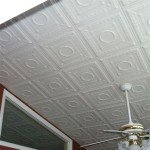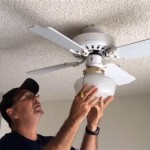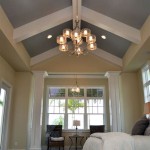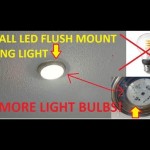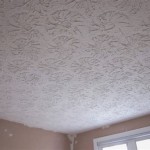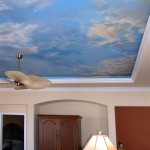How To Hang A Closet Rod On A Slanted Ceiling
Hanging a closet rod on a slanted ceiling presents a unique challenge compared to installing one on a standard, level ceiling. The sloped angle complicates the process of achieving a stable and functional clothes storage solution. However, with careful planning, proper tools, and a methodical approach, installing a closet rod on a slanted ceiling is a manageable DIY project. This article provides a comprehensive guide to successfully complete this task, ensuring a sturdy and aesthetically pleasing result.
Before embarking on the installation, it is crucial to assess the specific characteristics of the slanted ceiling and the intended use of the closet rod. Consider the following factors: the degree of the slope, the material of the ceiling (drywall, plaster, wood), the type and weight of clothing to be hung, and the desired length and placement of the rod. These considerations will influence the choice of materials, the installation technique, and the overall structural integrity of the final product.
Key Point 1: Planning and Material Selection
The initial stage of the project, planning, is arguably the most important. Accurate measurements and careful consideration of material selection are essential for a successful outcome. The angle of the ceiling slope will dictate the length and type of brackets needed, as well as the potential requirement for custom-fabricated solutions to ensure the rod hangs perpendicularly to the floor.
First, determine the desired height of the closet rod from the floor. Typically, a distance of 66 to 72 inches is recommended for hanging long garments, while a shorter distance may suffice for shirts and shorter items. Account for the added drop caused by the slanted ceiling; the higher end of the rod will naturally be lower than the lower end relative to the ceiling. Use a level and measuring tape to establish the desired height and mark the points on the walls where the rod will terminate. These points will serve as reference for positioning the support brackets.
Next, measure the distance between the two marked points on the walls. This measurement will determine the required length of the closet rod. Select a rod made of durable material, such as steel or heavy-duty aluminum, particularly if you plan to hang a significant amount of clothing. The diameter of the rod should also be considered; a thicker rod will generally provide greater strength and stability. Ensure the rod is long enough to span the distance between the support brackets but also short enough to be easily maneuvered during installation.
Selecting the appropriate brackets is paramount for supporting the weight of the clothing and maintaining the stability of the rod. Standard closet rod brackets designed for level ceilings will not work effectively on a slanted ceiling. Instead, opt for adjustable brackets or brackets specifically designed for angled surfaces. Adjustable brackets allow for fine-tuning the angle to ensure the rod hangs vertically. If adjustable brackets are unavailable or unsuitable, consider using custom-made brackets that conform precisely to the angle of the ceiling. These can be fabricated from metal or wood, depending on the desired aesthetic and structural requirements.
Beyond the brackets and rod, additional materials such as screws, wall anchors, and shims may be necessary to ensure a secure and level installation. The type of screws and wall anchors will depend on the material of the ceiling. For drywall, use drywall screws and appropriate wall anchors capable of supporting the expected weight load. For wood, use wood screws of sufficient length to penetrate deeply into the framing members. Shims can be used to level the brackets if the ceiling slope is uneven or if the wall surfaces are not perfectly plumb.
Key Point 2: Installation Process
Once the planning and material selection are complete, the next step is the installation process. This involves accurately marking the bracket locations, securely attaching the brackets to the ceiling, and installing the closet rod. Precision and attention to detail are crucial at this stage to ensure a stable and aesthetically pleasing result.
Begin by locating the ceiling joists or framing members behind the drywall or plaster. A stud finder is an invaluable tool for this task. Identifying and attaching the brackets directly to the joists will provide the strongest and most secure support. If it is not possible to attach the brackets to the joists, use heavy-duty wall anchors designed for the specific type of ceiling material. Ensure the anchors are rated to support the weight of the closet rod and clothing.
Using a level and measuring tape, carefully mark the locations for the brackets on the ceiling. Align the brackets with the marked points on the walls, ensuring they are evenly spaced and positioned to allow the rod to hang vertically. Use a pencil or marker to clearly delineate the screw holes on the ceiling. Double-check all measurements and alignments before proceeding.
Pre-drill pilot holes at the marked screw locations. This will make it easier to insert the screws and prevent the ceiling material from cracking or splitting. Use a drill bit that is slightly smaller than the diameter of the screws. For drywall, use a self-drilling screw or a drill bit specifically designed for drywall applications.
Attach the brackets to the ceiling using the appropriate screws and wall anchors. If attaching to joists, use wood screws of sufficient length to penetrate deeply into the wood. If using wall anchors, follow the manufacturer's instructions for installation. Ensure the brackets are securely fastened and can support the weight of the closet rod. If necessary, use shims to level the brackets and compensate for any unevenness in the ceiling slope or wall surfaces. The brackets should be as level as possible relative to the floor.
Once the brackets are securely installed, carefully position the closet rod within the brackets. Depending on the type of brackets used, the rod may simply rest within the bracket supports or require screws to secure it in place. Ensure the rod is centered and stable before tightening any screws. If the rod is too long, use a hacksaw or pipe cutter to trim it to the desired length. File down any sharp edges to prevent snagging of clothing.
Key Point 3: Ensuring Stability and Aesthetic Considerations
After the initial installation, it's crucial to verify the stability and weight-bearing capacity of the closet rod. Furthermore, paying attention to aesthetic details will enhance the overall appearance and functionality of the finished project.
Test the stability of the closet rod by applying weight to it gradually. Start by hanging a few lightweight items of clothing and gradually increase the weight. Observe the brackets and the rod for any signs of bending, sagging, or instability. If any issues are detected, reinforce the installation by adding additional brackets or using stronger wall anchors. It is better to over-engineer the support system than to risk the rod collapsing under the weight of clothing.
To further enhance stability, consider adding a center support bracket, especially for longer closet rods. This will prevent the rod from sagging in the middle and distribute the weight more evenly. The center support bracket should be positioned at the midpoint of the rod and securely attached to the ceiling joist or with a heavy-duty wall anchor.
Aesthetic considerations are also important. Ensure the brackets are neatly installed and aligned. The rod should be level relative to the floor, even though the ceiling is slanted. Conceal any exposed screws or fasteners with decorative caps or covers. Consider painting or staining the brackets and rod to match the surrounding décor. A consistent finish will create a more polished and professional appearance.
Finally, consider the functionality of the closet rod system. Ensure the rod is positioned at the optimal height for hanging clothing without dragging on the floor. Provide sufficient space between the rod and the wall to allow for easy access to clothing. If desired, add shelves or other storage accessories above or below the rod to maximize the available closet space. These additions will improve the organization and efficiency of the closet.
Properly installed closet rod on a slanted ceiling not only provides a functional storage solution but can also enhance the overall aesthetics of the room. By following these steps and paying attention to detail, it is possible to achieve a sturdy, efficient, and aesthetically pleasing result.

Angled Ceiling Closet Rod Hanger Brackets

Hanging Clothes Rod From Slanted Ceiling

Closet Ing Part 1 Diy In Pdx

Closet Rod Support Bracket Angled Wall

How To Install A Closet Rod On An Angled Wall

Closet Ing Part 1 Diy In Pdx

Hanging Clothes Rod From Slanted Ceiling

Angle Surface Bracket Tricky Angled Surfaces Are Not A Challenge

Angled Wall Closet Ideas

Sloped Ceiling Closet Rod Bracket
Related Posts

